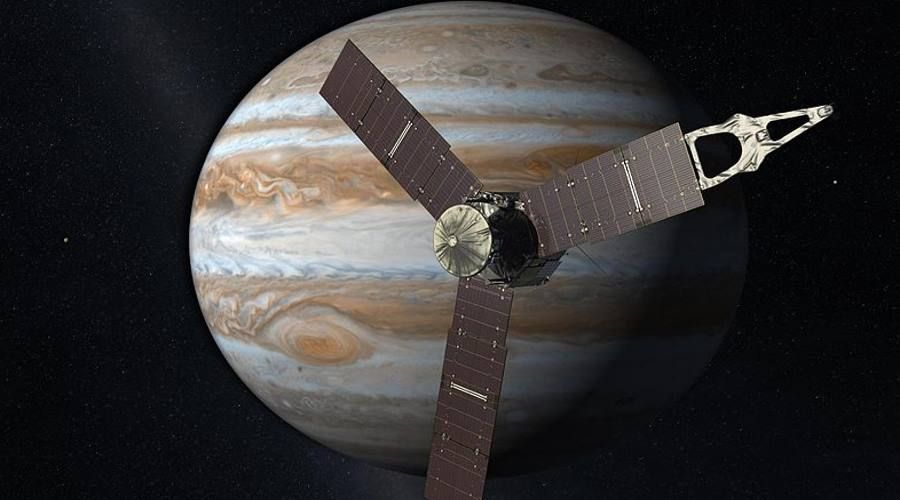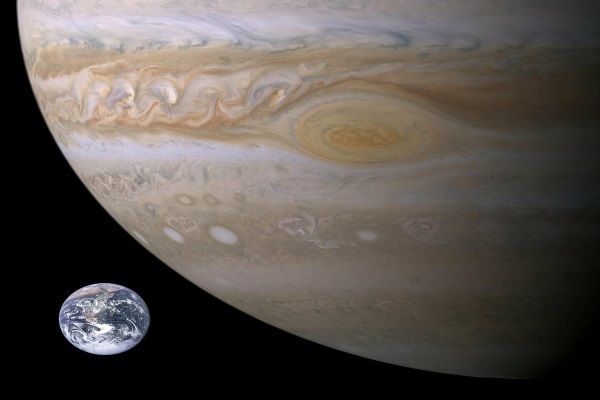
NASA’s breakneck mission. Juno probe approaches Jupiter
In August 2011, NASA sent a probe the size of a basketball court on a long journey toward the solar system’s largest planet, Jupiter. The Juno probe will come closer to the planet than any other probe before and give us a really close encounter with the gas giant.
On July 4, 2016, after nearly five years of flying and traveling nearly 600 millionóin a kilometerów, the Juno probe will perform a breakneck maneuver to enter Jupiter’s polar orbit. The probe will be exposed to many dangerous influences, m.in. to extremely strong X-rays. Juno aims to study the structure of the gas giant’s atmosphere, and measure the planet’s magnetic, gravitational and magnetospheric fields.
Most of the elementóJuno’s measurement and communications electronics are housed inside a titanium body, the so-called “Jupiter Body”. of a one-centimeter-thick vault. For energy production, the spacecraft is equipped with three solar wings. Juno’s propulsion system consists of a main engineóand 12 enginesóin corrective. Juno’s total structural mass is just over 1.5 tons, and the mission will cost approximately one billion 107 millionóin the dollarów.
There is not much time left before the start of the most important stage of the mission. NASA announces a Hollywood-style mission. See for yourself!
The mission is led by Scott Bolton, Ph.D., of the Southwest Research Institute in San Antonio, Texasóby Jet Propulsion Laboratory scientist Steve Levin. – We’re not looking for troubleóin, we are looking for data – Bolton admitted. – The problem is that conducting research near Jupiter is associated with finding yourself in an environment in whichóand it’s easy to get into trouble – added.
The harshest conditions in the entire solar system
According to the planóThe Juno probe is expected to make 37 close approaches to the gas giant, collecting and transmitting valuable data back to Earth. The probe itself will be exposed to extreme interactions. Throughout its mission, Juno will receive a dose of X-ray cfócomparable to 100 million dental x-rays.

Jupiter with its distinctive Great Red Spot and Earth to cfóto recognize the scale of sizeóin the gas giant
Sourceóthe problemóThere may also be a layer of hydrogen, whichóand Voyager is located below the top ofóin Jupiter’s clouds. At the pressure prevailing on Jupiter, the wateróThe probe itself will be exposed to extreme interactions with Jupiter. According to researchers, combining this with the planet’s rapid rotation generates an unusually strong magnetic field, whichóThe water surrounds the gas giant. The result is that the electrons, protons and ions in its interior acquire velocities close to the speed of light.
According to NASA, conditions near Jupiter are the harshest in the Solar System. If Juno didn’t have a titanium armor, it would be impossible to fly by Jupiter, including Europaóto make any measurementsów.
Jupiter is the largest planet in the Solar System. Its mass is two and póThe mass of all the other planets in our system. Jupiter has at least 67 moonsów. The planet is covered by several layers of clouds, whichówhich form characteristic stripes visible from our planet. A day on Jupiter lasts about 10 hours. The most recognizable detail of Jupiter is the so called “Jupiter’s core”. The Great Red Spot, whichóis actually an anticyclone, and its diameter is larger than the diameter of the Earth.
The Juno mission is not the firstóra will explore Jupiter. Earlier probes from the program Pioneer and Voyager flew near the gas giant. The largest planet in the Solar System was also studied by Galileo and New Horizons, whichóthe target was Pluto. NASA plans to explore several moons in the futureóin Jupiter, including Europa, whichóra has an ocean of water under its ice cap.

